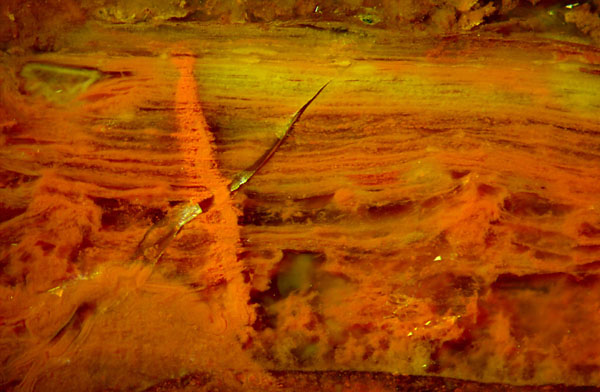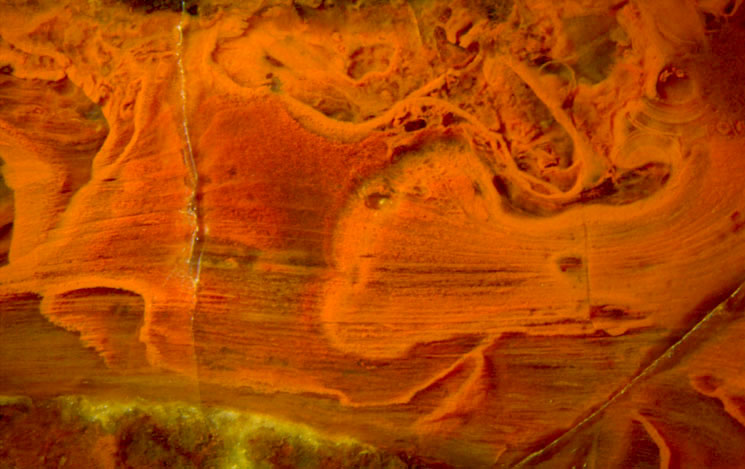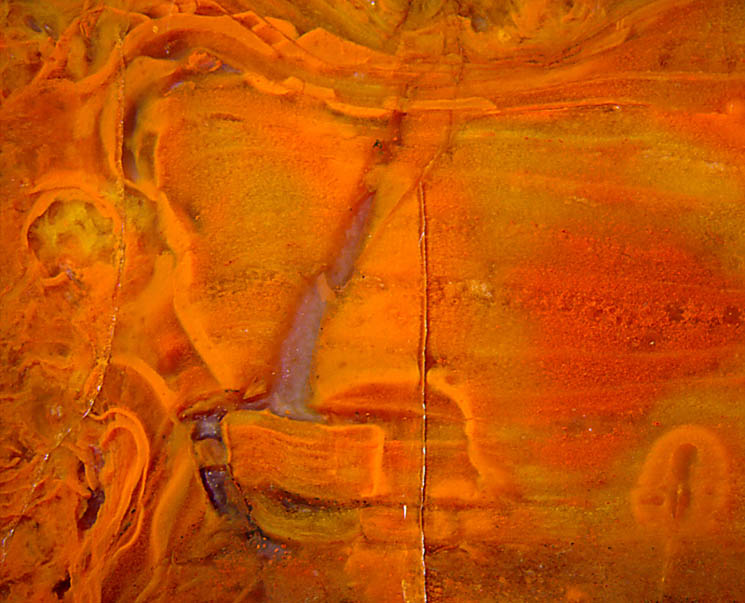Eerie shapes athwart microbial layer
stacks -
(2)
 The
eerie
shapes presented in Permian
Chert News 18
seem to defy any explanation, hence they may give rise to awe
and wonder. More of such are shown here. One of them is the
red streak in
Fig.1. Obviously it had not
been a wide crack since the horizontal microbial layers are seen to go
right through, without being disrupted. The read streak
does not only cross the
layer stack but an
old crack, too. Its sharp tip and smooth flanks indicate that it
propagated
when the layer stack was an elastic homogeneous body since its
propagation
was not affected by the layered structure. It seems to have been silica gel with a
crack filled with water enriched with dissolved silica which enabled
the crack to "heal". Later, the layer stack and the healed
crack became traversed
by the mysterious red streak.
The
eerie
shapes presented in Permian
Chert News 18
seem to defy any explanation, hence they may give rise to awe
and wonder. More of such are shown here. One of them is the
red streak in
Fig.1. Obviously it had not
been a wide crack since the horizontal microbial layers are seen to go
right through, without being disrupted. The read streak
does not only cross the
layer stack but an
old crack, too. Its sharp tip and smooth flanks indicate that it
propagated
when the layer stack was an elastic homogeneous body since its
propagation
was not affected by the layered structure. It seems to have been silica gel with a
crack filled with water enriched with dissolved silica which enabled
the crack to "heal". Later, the layer stack and the healed
crack became traversed
by the mysterious red streak.
Obviously, the crack and the red
streak behaved quite differently with respect to the layer stack. The
layered structure appears mechanically irrelevant but important for
diffusion: The bright red had spread for a short
distance along the layers on either side of the streak.
It is well known that stains may diffuse through hard chalcedony but possibly the
aspect of
Fig.1 had formed at an
earlier stage while everything was still
gel-like. It appears that Fig.1
has not brought us nearer to an explanation of
the eerie shapes, and this may also apply to Fig.2 and Fig.3.

Fig.1 (above): Microbial deposits traversed
by crack and mysterious streak.
Image
width 3.5mm.
Fig.2: Microbial layer
stack interfered with enigmatic phenomena
apparently mediated by diffusion. Image
width 8mm.
Fig.3 (below): Indistinct layer stack with early and late
cracks and with diffusion effects.
Image
width 8mm.

It is hard to imagine how the wondrous aspect could be brought about by
diffusion. Among the confusing structures,
small details are clearly due to diffusion: the bleaching along the
late cracks in Fig.2, and the bleaching and colouring around the crack
tip in Fig.3 below right. Hence, one can assume that everything except
the microbial structures and the cracks is mediated by diffusion but
one cannot tell how diffusion could have produced what is seen here.
The layer stack in Fig.3 seems to be inclined agains the cut plane so
that the layers appear indistinct and far apart. It had been broken off
on the left while still soft. Another early crack, with wide opening
and filled with bluish chalcedony, runs across
the stack but not farther, which shows that the stack had been elastic
while the surroundings had been fluid. Two late cracks with very small
openings in Fig.3 run beyond for a short distance, which
shows that the stack and the
surroundings had been
solid and hard
when they formed.
Also it can be asssumed that the cracks are due
to shrinkage stress arising when the stack hardens and shrinks faster
that the surroundings. Several other cracks of finite length but short
compared to the height of this chert sample of 24cm are due to
inhomogeneous stress of unknown cause,
like the crack of 6cm length whose tip is seen in Fig.3 below right and
has been mentioned above.
Sample: H/375.1, old
fragment (12kg) of a Lower Permian chert layer, found in 1999 among glacial river deposits at Hänichen,
Döhlen basin, Freital near Dresden, Saxony.
H.-J.
Weiss 2020
|
 |
 27 27 |

 27
27 The
eerie
shapes presented in Permian
Chert News 18
seem to defy any explanation, hence they may give rise to awe
and wonder. More of such are shown here. One of them is the
red streak in
Fig.1. Obviously it had not
been a wide crack since the horizontal microbial layers are seen to go
right through, without being disrupted. The read streak
does not only cross the
layer stack but an
old crack, too. Its sharp tip and smooth flanks indicate that it
propagated
when the layer stack was an elastic homogeneous body since its
propagation
was not affected by the layered structure. It seems to have been silica gel with a
crack filled with water enriched with dissolved silica which enabled
the crack to "heal". Later, the layer stack and the healed
crack became traversed
by the mysterious red streak.
The
eerie
shapes presented in Permian
Chert News 18
seem to defy any explanation, hence they may give rise to awe
and wonder. More of such are shown here. One of them is the
red streak in
Fig.1. Obviously it had not
been a wide crack since the horizontal microbial layers are seen to go
right through, without being disrupted. The read streak
does not only cross the
layer stack but an
old crack, too. Its sharp tip and smooth flanks indicate that it
propagated
when the layer stack was an elastic homogeneous body since its
propagation
was not affected by the layered structure. It seems to have been silica gel with a
crack filled with water enriched with dissolved silica which enabled
the crack to "heal". Later, the layer stack and the healed
crack became traversed
by the mysterious red streak. 


 27
27